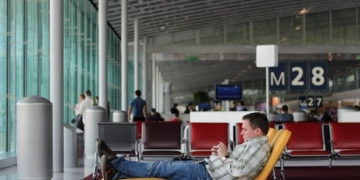According to statistics, 1 in 3 people are prone to motion sickness. It’s a common ailment associated with travel but many people are not aware of what triggers it.
Motion sickness occurs when your inner ear detects movement that your eyes can’t see. It also happens the other way around – when your eyes can see movement but your body can’t feel it.
The imbalance leads to nausea, sweats, dizziness, or fatigue.
Here are six proven steps on how to avoid motion sickness next time you fly or drive.
- Monitor what you eat
Many believe that stuffing their stomach before flying is a good way to prevent hunger mid-flight. However, when your stomach is full, you are actually more prone to dizziness as the body processes the food while it adjusts to the elevation.
It’s best to eat a light meal and avoid salty or greasy foods before flying. Also, don’t forget to drink up to prevent dehydration.
- Pick a good seat
Just like on a bus, the seats at the back give you a bumpier ride. If you are paying for a select seat, choose a seat closer to the front, over the plane wings.
- Avoid reading
Eye movement messes with your equilibrium. Avoid reading in-flight especially when the plane is speeding on the runway or when it’s currently taking off.
- Keep a steady air flow
To prevent nausea and claustrophobic feelings, turn your air vent on while in transit.
- Pressure point
Did you know that putting pressure into your wrist about 50mm above the crease in your wrist can minimise motion sickness? Yes, this particular pressure point improves your circulation and energy flow.
What’s your best tip in avoiding motion sickness without taking tablets?

![7 Great Ways To Earn Money [Without Needing To Go To Work]](https://blog.thebananastand.com.au/app/wp-content/uploads/2020/05/united-nations-covid-19-response-DZL1pR-htwo-unsplash-1-360x180.jpg)
![Top 5 Weekly Deals To Get Your Hands On [01.07.2020]](https://blog.thebananastand.com.au/app/wp-content/uploads/2020/04/artem-beliaikin-pPzQP35zh4o-unsplash-360x180.jpg)
![Here Are 4 Ways You Can Make Money From Home [Just Use Your Smart Phone]](https://blog.thebananastand.com.au/app/wp-content/uploads/2020/04/annie-spratt-Jr8byYZmTTU-unsplash-1-360x180.jpg)






























![7 Great Ways To Earn Money [Without Needing To Go To Work]](https://blog.thebananastand.com.au/app/wp-content/uploads/2020/05/united-nations-covid-19-response-DZL1pR-htwo-unsplash-1-120x86.jpg)
![Top 5 Weekly Deals To Get Your Hands On [01.07.2020]](https://blog.thebananastand.com.au/app/wp-content/uploads/2020/04/artem-beliaikin-pPzQP35zh4o-unsplash-120x86.jpg)
